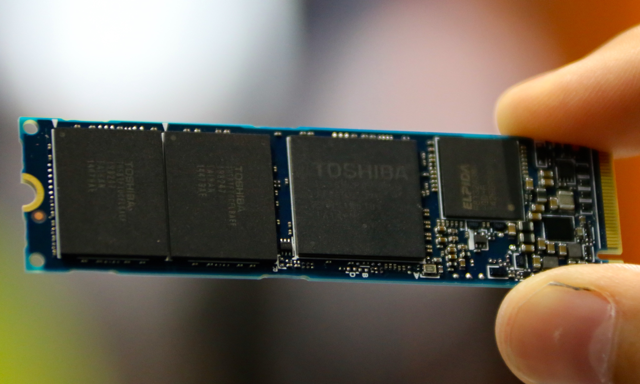

The 512GB drive is rated for 296 terabytes written, and it’s guaranteed under a five-year advance-replacement warranty program. When it comes to endurance and warranty information, though, Toshiba is happy to share. We can guess that Toshiba took that controller as a baseline and added some NVMe support into it before slapping it on the RD400. Inscribed on the controller chip are letters and numbers starting with “TC58.” TC58 was how Toshiba referred to the controller inside the Trion 100 and 150-series drives. And you can be sure that if the company had something newer, smaller, or faster, it would have been a prominent bullet point on the drive’s feature list. We can infer that the MLC flash in the RD400 is fabbed on Toshiba’s 15-nm process, as 15-nm NAND is all the company has been shipping recently. An unfortunate side effect of the Toshiba acquisition has been a steadily increasing unwillingness on OCZ’s part to discuss the guts of its products, but we’ll forgive the company its reticence if its drives continue to impress. The marketing materials and spec sheets for the RD400 are a bit light on technical details, so all we know officially is that the drive packs a Toshiba controller and Toshiba MLC NAND. Under the Toshiba umbrella, OCZ released some great products-the Arc 100 and Trion 150 even earned TR Recommended awards. Toshiba has done some great work rescuing the OCZ brand from its association with unreliability and bankruptcy, so it makes sense that they’re keeping the name around. The Trion 150 became the TR150, the Vector 180 became the VT180, and the as-yet-unreleased RevoDrive 400 became the RD400. So what’s with the RD400 name? Recently, Toshiba rebranded many of its OCZ consumer products under the Toshiba OCZ umbrella. It comes in a few capacities, each of which can be optionally bundled with a PCIe-to-M.2 adapter. Make no mistake, this is a full-fat PCIe 3.0 x4, NVMe, M.2 2280 drive.
#OCZ REVODRIVE 400 NVME SSD ALAUNCH SERIES#
We first heard about this drive at IDF back in August, and we’ve been excited ever since at the prospect of a true competitor to Intel’s 750 Series SSDs and Samsung’s 950 Pro. The winds of change may finally be upon us, though, as Toshiba is joining the NVMe fray.įeast your eyes on Toshiba’s OCZ RD400, née the OCZ RevoDrive 400.
#OCZ REVODRIVE 400 NVME SSD ALAUNCH PRO#
Ever since the 950 Pro hit the shelves, though, the market landscape for modern, high-end consumer SSDs really hasn’t changed all that much. It didn’t hurt that Intel’s Skylake platform brought an abundance of of PCIe lanes to the masses, and the NVMe protocol promised a major advance in performance versus the older AHCI, too. While Intel’s 750 Series SSDs paved the way for next-gen SSDs on the desktop, the 950 Pro made the M.2 2280 form factor popular for retail storage devices. Back when Samsung’s 950 Pro SSD debuted last year, it marked a turning point in the ongoing storage revolution.


 0 kommentar(er)
0 kommentar(er)
